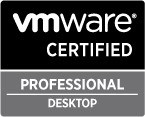 Reading Time: 5 minutes
Reading Time: 5 minutesAs written in a previous post, I was not able to participate at the beta exam for VCP5-DT (due to no available seats in my Country). So I waited for the official exam also also when I’ve got at least a free day to study for the exam. Yesterday finally I’ve taken the exam and I’ve passed it, so my VCP-DT certifications is updated to v5.
As written in the certification official page, the only requirement is have the VCP5 certification, no classes or other certification are mandatory. One year ago was also required the VCA-DT certification but the certification path change for VCP4-DT has been changed. Actually there is no info about a v5 of the VCA-DT (as also still no info about the VCAP-DT!).
Unfortunately there isn’t a preferred or different path for who is already a VCP4-DT: the path is the same of new people and also the exam cost the same… Honestly I’ve expected at least a time limited discount for the exam (but probably the only bonus was to be invited at the beta of the exam).
Compared to the VCP4-DT exam (also in this exam I was not able to attend at the beta version) the price is now finally the same of a VCP exam and also the testing centers are the same (the usage of only “selected” center was a big and non simple to understand limit of the previous version and also for the beta).
As well described in VCP5-DT Exam Blueprint the exam consists of 85 questions and a short pre-exam survey consisting of 7 questions, the limit for the exam is 90 minutes, with an additional 15 minutes to complete the survey questions and agreements. Candidates who take the VCP510-DT exam in a country where English is not a primary language will have an additional 30 minutes added to the exam time.
You may think that are a lot of questions (note that in some cases there are also medium/long questions) in few time. You are right! You need to managed your time well and use in the best way the review function to do not spend too much time on a single question. I’ve finish in 90 minutes, but including a review of most of the questions.
The questions are all closed questions, but several are multi-choices (with two or three answers!). Also note that sometime there isnt’t the best answer, you may choose which fit better. You can also work in the reverse mode… you can simple exclude some answers and then focus on the remaining. Also in some cases the answer of one question could be in the text of another one. Or some questions may be quite similar (and just ask the same thing). So be sure to read carefully all the questions and the answers.











